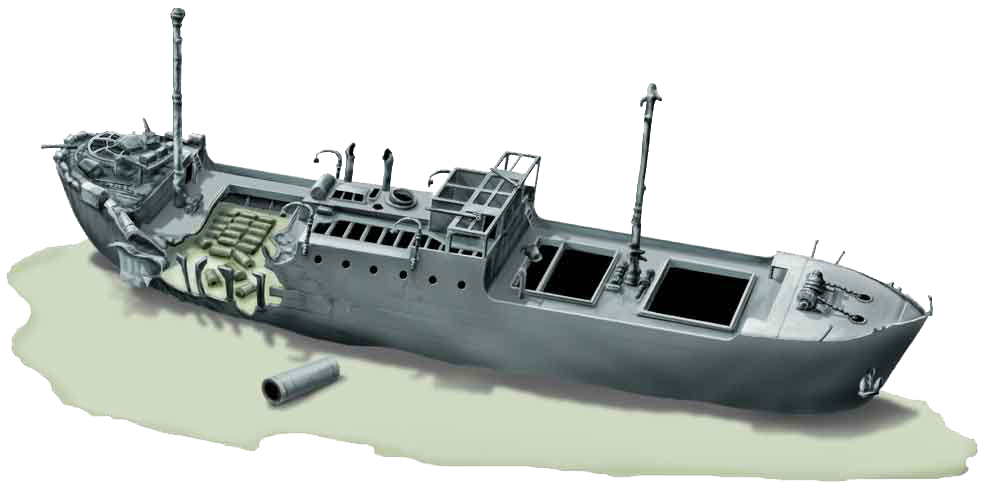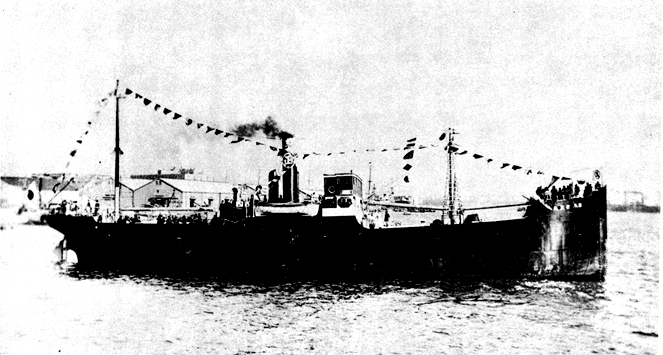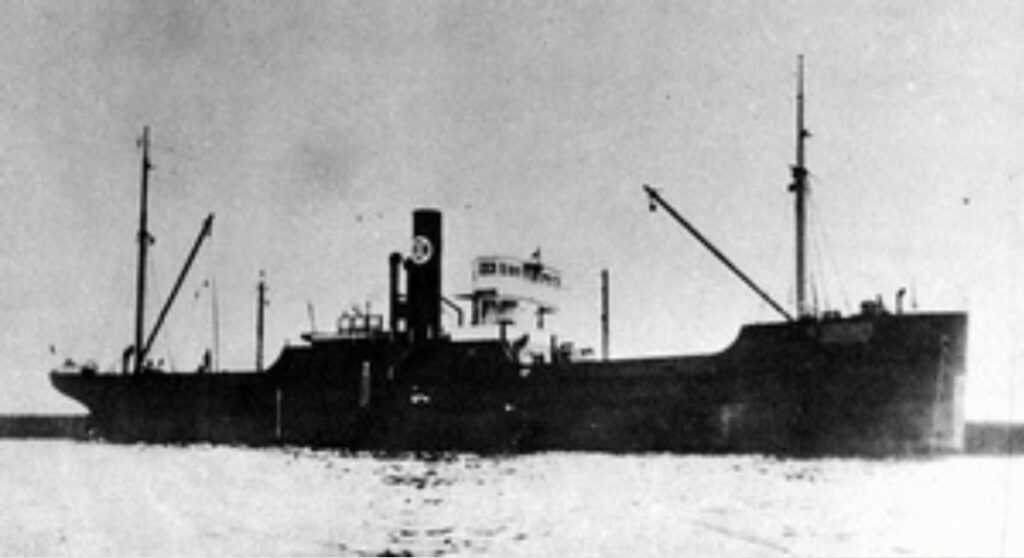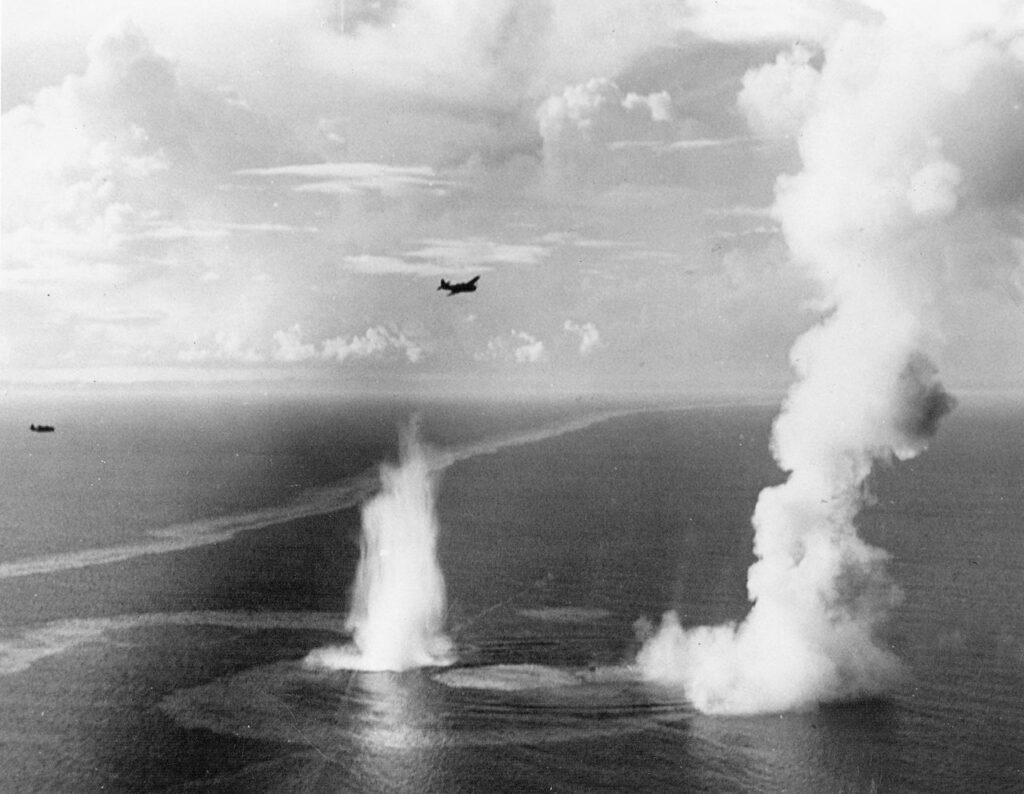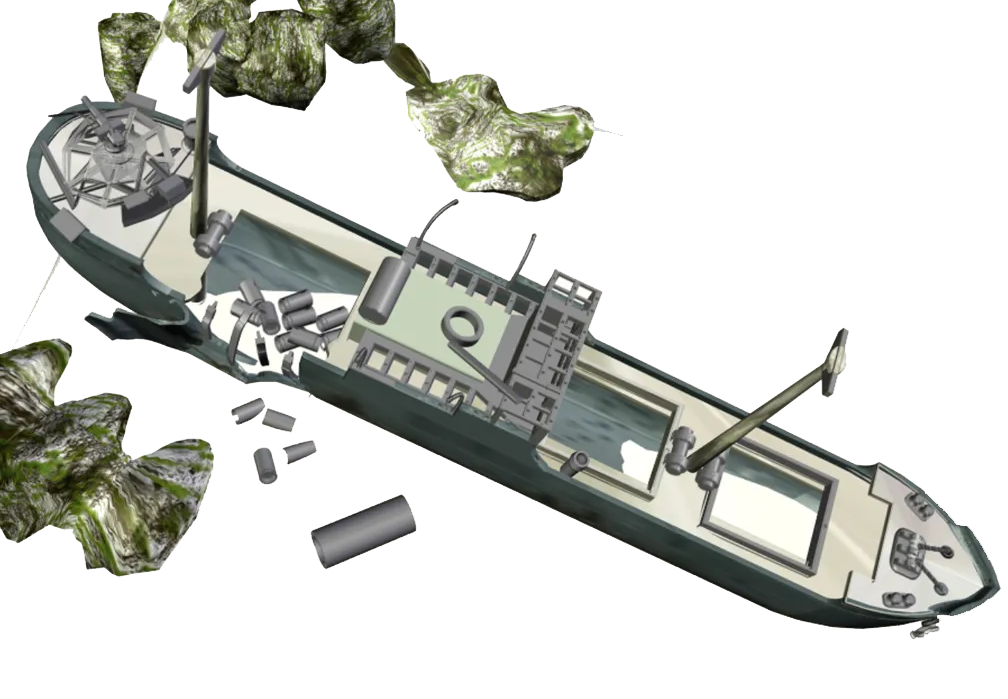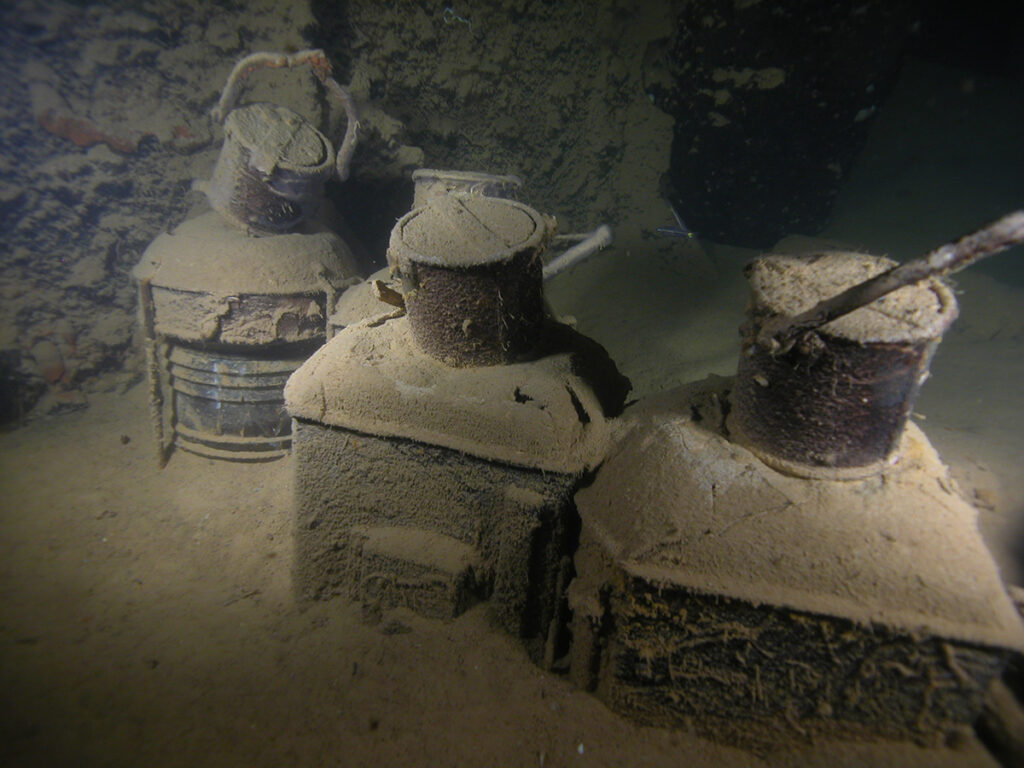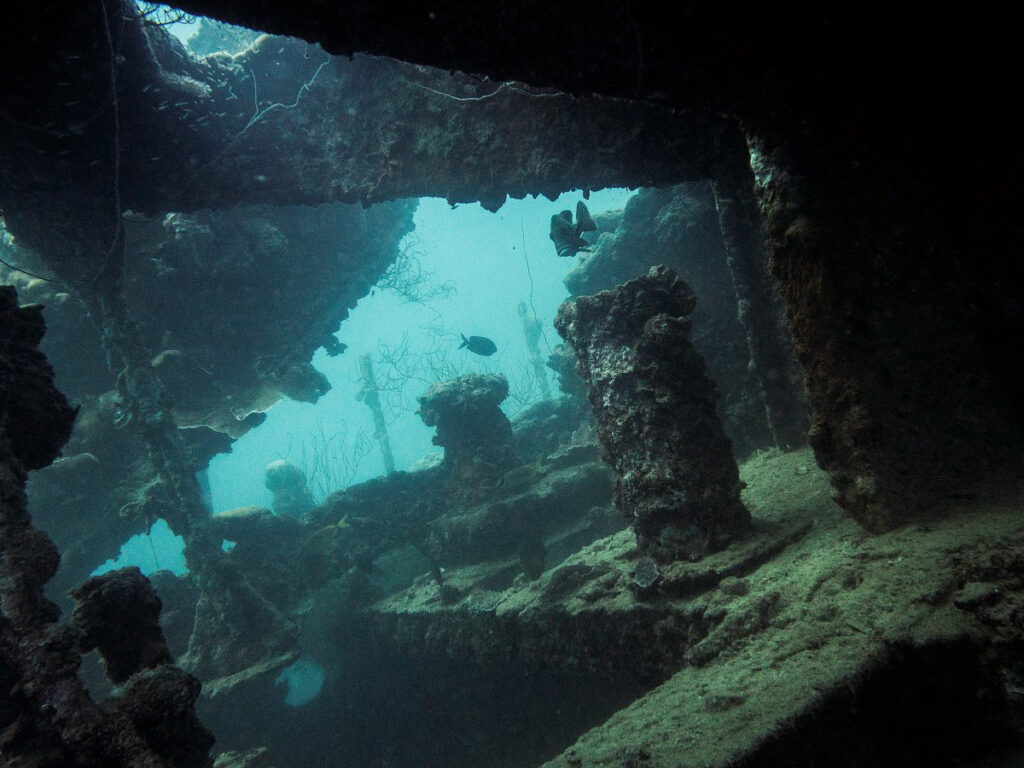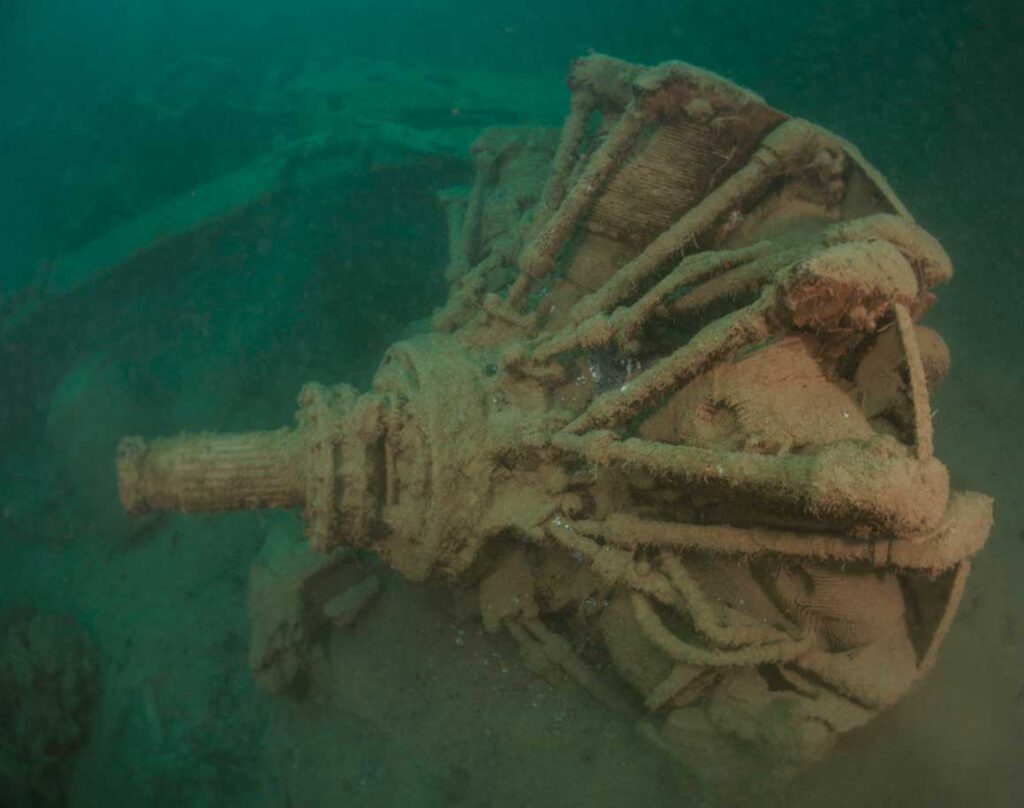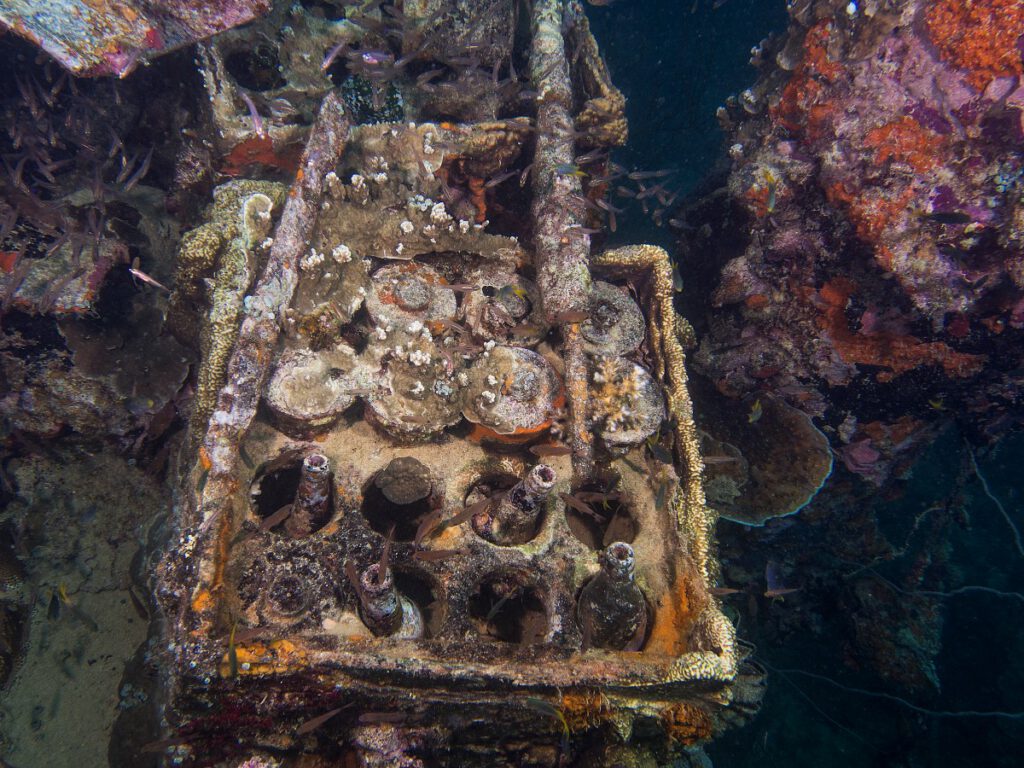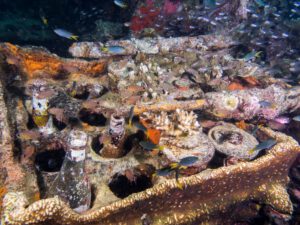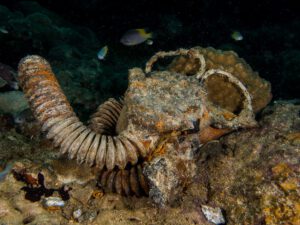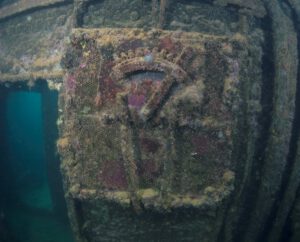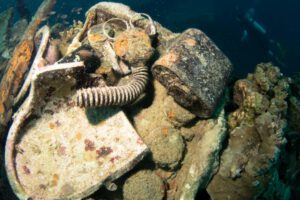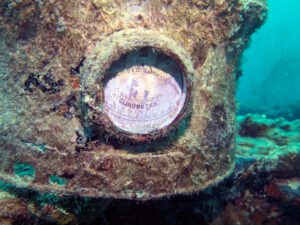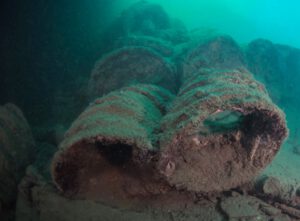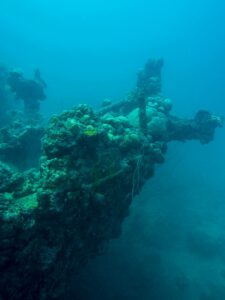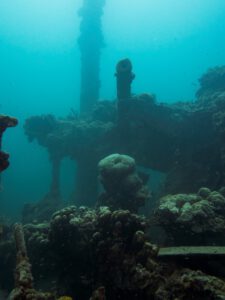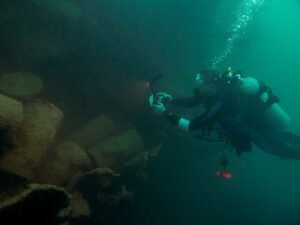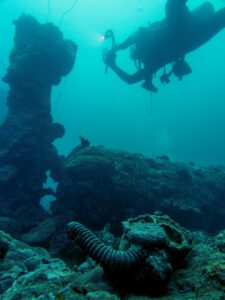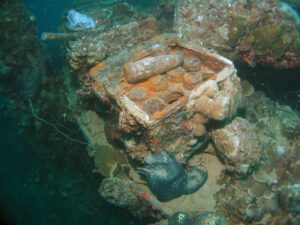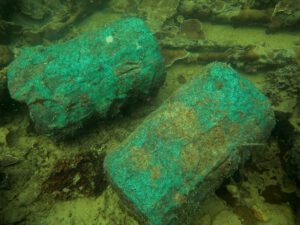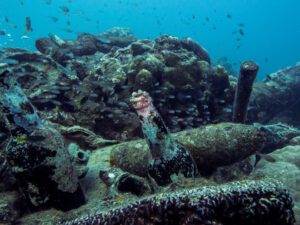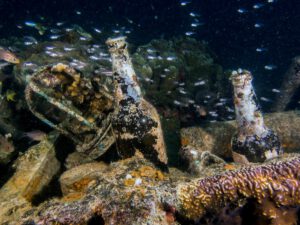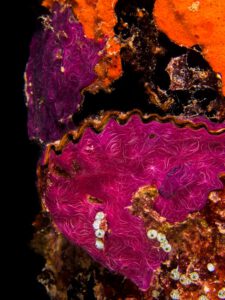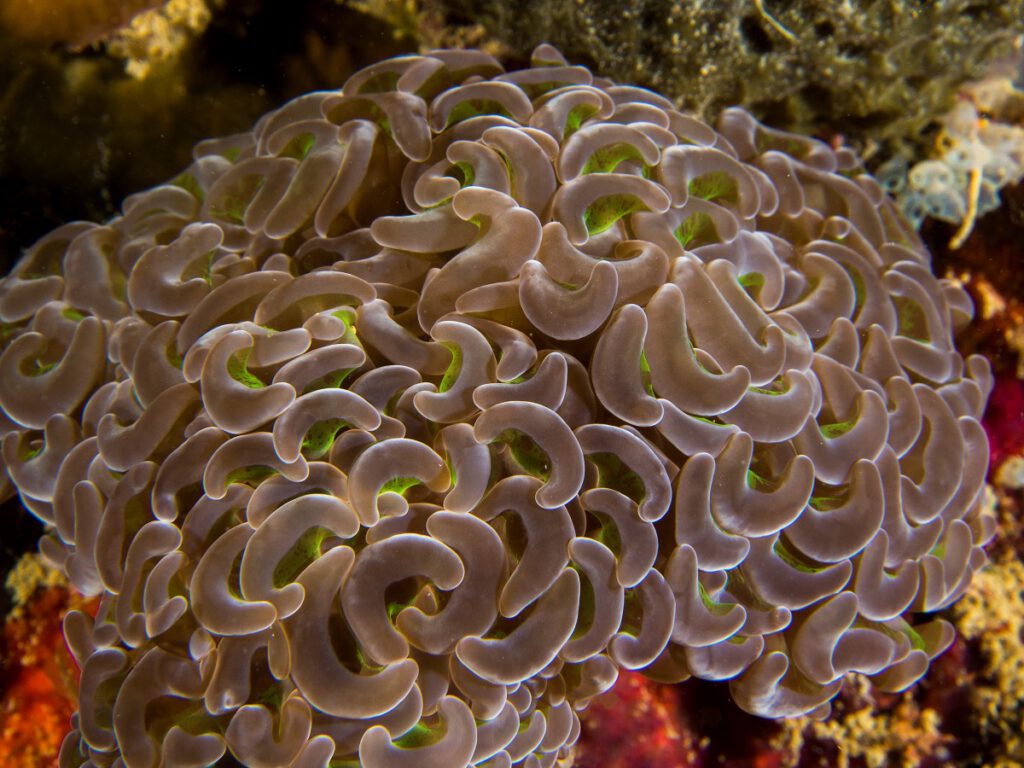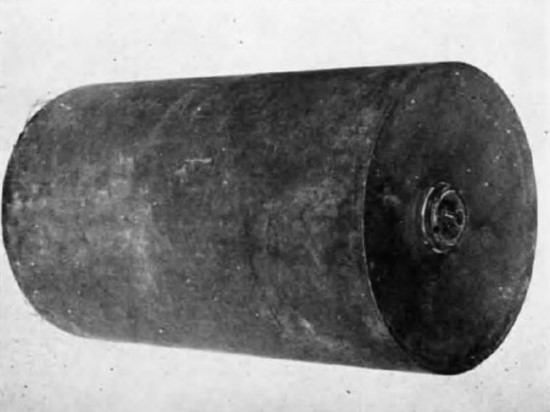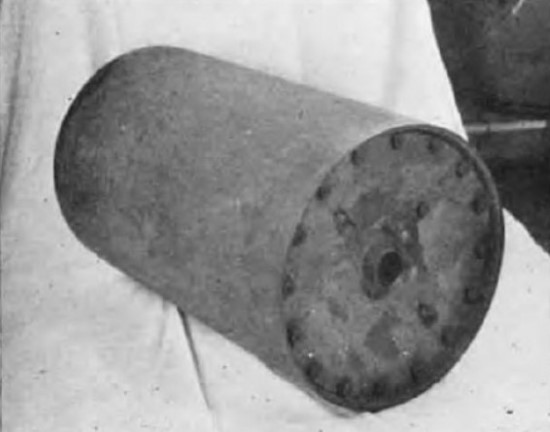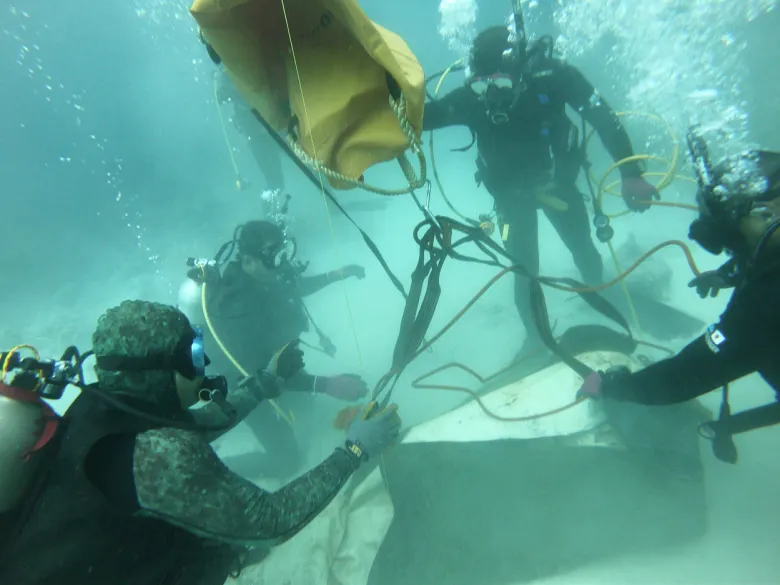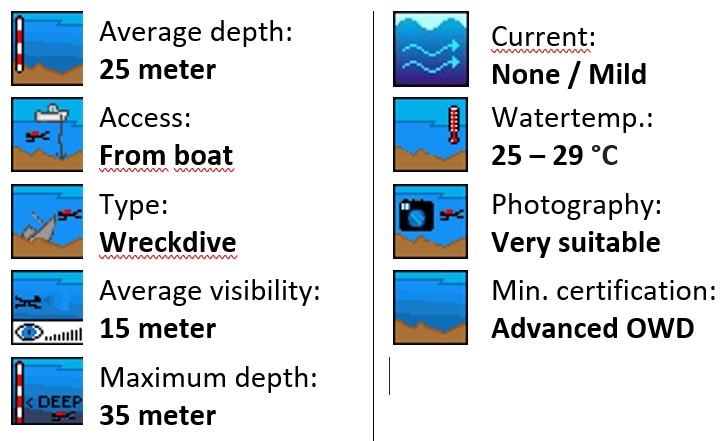The Helmet wreck - Palau - Micronesia
The name Helmet Wreck is prolific amongst the dive shops in Palau due to the fused rows of helmet stacks still present in the stern hold.
The ship was sunk during Operation Desecrate One (March 30 – March 31 1944) by the U.S. Army
It’s a time capsule of World War II, filled with preserved artifacts, eerie relics, and thriving marine life.
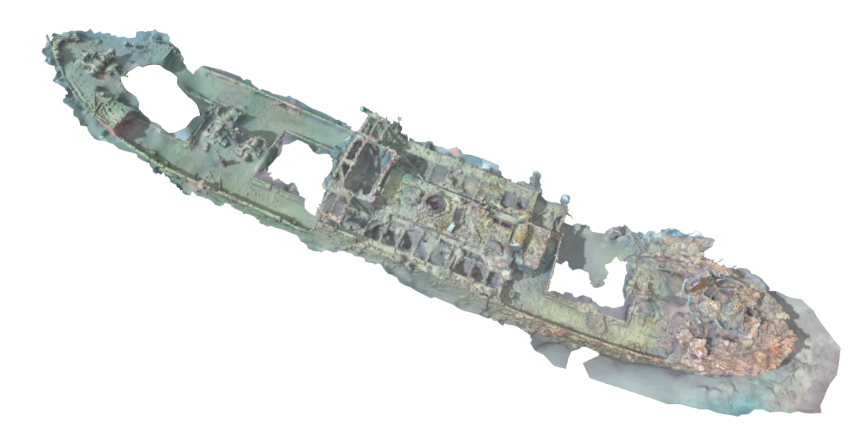
The Helmet wreck - Palau - Micronesia
The Helmet wreck was sunk during Operation Desecrate One, a series of US airstrikes on the Japanese fleet in Palau in March 1944.
The ship was hit by multiple bombs and possibly torpedoes, causing it to sink on the NE side of Ngargol Island.
It was discovered in the late 1980s and is also known as the Depth Charge Wreck. The wreck is located in Malakal Harbor and rests on a slope, with the stern at about 35 meters and the bow at 15 meters.
NOTE: We make use of “Sketchfab” click HERE to view the navigation controls
Click on the 3D model below to move it around
All credits to the above Photogrammetry model goes out to Iho Melekhin
The story & the dive
The Mystery
What we do know: this ship was likely sunk during Operation Desecrate One in March 1944. Its forward section bears signs of an explosion, possibly from an internal detonation.
No official records confirm its name, only adds to the mystique.
But the story goes that this is the IJN NISSHO MARU No. 5
The official last logs of the IJN NISSHO MARU No. 5, a coastal freighter transporting military supplies and equipment:
24 March 1944:
NISSHO MARU No. 5 arrives at Palau.
31 March 1944:
At Palau Harbor, Western Carolines. Bombed and sunk by Task Force-58 carrier aircrafts with unknown casualties.
The ship took a hit to the bridge as well as hull damage and sank on the NE side of Ngargol Island.
This is completely consistent with the location, size of the ship and what witnesses stated.
Altrough it’s official identity is still unknown, we will here assume it’s the IJN NISSHO MARU No. 5
The data
- IJN NISSHO MARU No. 5
- Builder: Osaka. Ohara Zosen Tekkosho K.K.
- Year Completed: 1935
- Gross tonnage: 782-tons.
- Length: 57.6 meters
- Beam: 9.5 meters
- Propulsion: One triple expansion reciprocating steam engine, one shaft, 490 bhp.
- Speed: Cruising 9 knots. – Max: 10.5 knots.
- Armament: As netlayer: (standard armament):
- One 8cm/40cal deck gun
- One DC launcher
- Two DC racks
- 24 DCs
- Two catching nets
- One K type hydrophone.
The story
Discovered in the late 1980s the Helmet Wreck, aka Depth Charge Wreck, aka X1 is a small old-fashioned coaster.
It sunk during DESECRATE ONE operation by planes operating from the US Aircraft carrier the USS Lexington on March 30, 1944.
It took over seven (7) 500 lb. bombs and four torpedoes to finally sink the vessel where it now lies tucked inside Malakal Harbor, resting upright at the base of a hill with the stern in 35 meters and the stern in 15 meters of water.
It is quite remarkable that the bomb that sank the ship was dropped on the aft hold and ripped the starboard side wide open but did not detonate the over 85 depth charges later found intact in the same hold.
(The initial American air offensive called DESCRATE ONE, began in March 1944 with carrier based aircraft from the US Pacific Carrier Task Force 58 attacking military vessels, aircraft and merchant shipping. The operation sent many Japanese ships and aircraft to the bottom of the harbors and water surrounding the Palauan Islands)
The Dive
This small ship is only 58m long and lays on a sloping part of the harbor bottom.
The stern can be reached at 15m but the bow drops down to 35m.
The wreck is packed with interesting artifacts. Gas masks, sake bottles and jugs, china, assorted blue and brown blown glass medicine bottle’s, boxes of rifle and cannon ammunition, machine guns and stacks of depth charges are just some of the interesting things.
There are excellent photo opportunities on all areas of this wreck.
Inside the wreck, divers can find:
Dozens of steel helmets, stacked like they were just unloaded, gas masks (many still surprisingly intact), ammunition boxes, depth charges (carefully lined in racks), Sake bottles, jars, medical vials, and crates of ceramic goods and more…..
These artifacts give the Helmet Wreck an almost museum-like quality, except you’re swimming through it instead of walking past glass.
There are open cargo holds and hatches, making it relatively easy to explore. The structure is tight in some places but not claustrophobic, and for divers with good buoyancy control, it’s an incredibly rewarding dive.
From the very start of the dive, you’re greeted with a powerful sense of history.
The ship’s bow is twisted and torn open, likely from a munitions explosion, offering an immediate look into the cargo holds.
The Stern
Dropping in along the mooring line, tied off to the stern of the ship, the deck materializes after a depth of 15 meters. One of the first sights divers come across is a round aft gun platform immediately following degrading and twisted guardrail guiding the diver down to the bow of the ship.
The first sight that will immediately attract the most attention is a round aft gun platform with its gun barrel pointing to port amid the mangled steel of the collapsed gun mount.
There were once two depth charge release boxes with active charges ( these charges were removed in 2013-2014) located on each side of this platform.
Damaged deck gear, with scattered debris leading out onto the sandy bottom.
Behind the stern, there are rich coral formations of Stag Horn corals, Brain corals, and Lettuce corals. Many species of tropical fish and a large selection of invertebrates can be found here, making it an ideal site for marine life enthusiasts.
Here you can take a look at the propeller and rudder that are still intact. The rectangular rudder, is clearly visible, and it’s noticeable that no damage was done to this portion of the ship.
In the shallower part have a quick swim into a dark stern compartment, here you find a row of brass lanterns sitting half buried in the silt.
The twisted and deteriorating guardrail surrounding the aft deck can serve as a guide while swimming down in the direction of the bow.
Amidships
The amidships superstructure is box-like, and along the port side, you will come to the engine room’s skylights and a pair of engine room ventilators that tower upward. The ship’s main stack, now sitting on the bottom on the starboard side, left a gaping hole in the middle of the deck.
There is an inner passageway leading to several small rooms and a catwalk above the engine room.
You can gain entry to the engine room via this catwalk.
The wooden roof to the bridge is gone, allowing easy access to the wheelhouse.
The Bow
On the raised bow, divers can find a two-headed anchor winch with anchor chains extending into the chain holds and to the anchors. Inside the forecastle, there are brass lanterns and an old taffrail log, a speed-measuring device.
The (bound together after decades of corrosion) helmets are a very popular sight, but don’t miss the piles of rifles, ammunition and gas masks, belts and shoes peeking out amongst the sediment.
The forward holds are penetrable through 2 large hatches on both sides of the forward light mast. No partition between the two holds exists, so divers can swim right through. The bow is half full of silt but amongst the maze of electronic equipment and ceramic jars, there are 3 huge radial engines for Zeke fighter planes are clearly visible.
Below some pictures of the wreck
Flora & Fauna
Look closely amidst the rich coral formations of stag horn, brain and lettuce corals and spot a few Banded Pipefish.
Shrimp peer their heads out from time to time and so do the territorial Tomato Anemone Fish.
Divers should keep their eyes out for the Lionfish and Stonefish hiding along the walls and the resident Yellow Ribbon Eel known to hide out on the fore and aft mast.
And, of course, the ever-present tropical fish and ample amounts of invertebrates can be found in, on and around Helmet Wreck.
Depth charges
While the specific type of depth charges is not consistently identified in all sources, some dive site descriptions mention both depth charge release boxes and the presence of these historical ordnance.
Some sources identify Japanese Navy WWII Type 95 depth charges among the cargo, and one specific reference mentions “Type 2 Depth Charges” that were safely removed from the wreck, which contained ammonium picrate.
Both are the same in shape an size: Cylindrical, 45cm in diameter and 80cm long.
Over 82 tons of unexploded WWII bombs cleared from Helmet Wreck
May 2025 – KOROR, Palau
More than 82 tons of unexploded World War II bombs have been removed from a sunken ship in Malakal Harbor, ending a seven-year operation of the Japan Mine Action Service (JMAS).
The ship, known as the Helmet Wreck, was a Japanese merchant vessel converted for wartime use during WWII. It was sunk with 469 depth charges aboard and lay undisturbed on the ocean floor for 81 years before the dangerous cargo was finally cleared.
JMAS, working alongside the Palau government, Koror State, and Norwegian People’s Aid (NPA), removed the deteriorating depth charges—each weighing about 160 kilograms (352 pounds) and measuring roughly 2.5 feet long and 17 inches in diameter. The charges, which contain ammonium picrate, a highly toxic explosive compound, were leaking hazardous chemicals into the surrounding waters.
“Visitors, especially divers, may not be happy because this was a popular dive site, but I believe the removal was necessary for the safety of everyone, including marine life,” said Shimada Masato, a JMAS representative. He explained that many of the bomb casings were cracked, with orange-yellow toxic liquid seeping out.
The removal was a painstaking process. Each bomb had to be sealed to prevent leaks, bagged individually, brought to the surface, and transported overland to a demolition site in Babeldaob. There, NPA incinerated the bombs.
Despite the complexity and risks, Shimada said the project was completed safely without accidents. He credited the Japanese government’s support and funding for enabling the operation, which aimed to eliminate the threat posed by WWII-era ordnance in Palau’s waters.
JMAS (Japan Mine Action Service), is a Japanese non-profit, non-governmental organization specializing in demining and unexploded ordnance removal worldwide.

Words of Caution when diving Helmet Wreck
Although the Helmet Wreck has come to rest lying on a sandy bottom it is not advised to penetrate this wreck because the structures are very unstable. And like most other ship and plane wrecks found in Palau waters live ammunition may still be present today.
Although JMAS has removed a lot of ammunition, there is still a possibility that live ammunition remains in and around the wreck.
Picking of live ammunition is extremely dangerous due to their age and volatility; they can explode or leech unsafe products if disturbed.
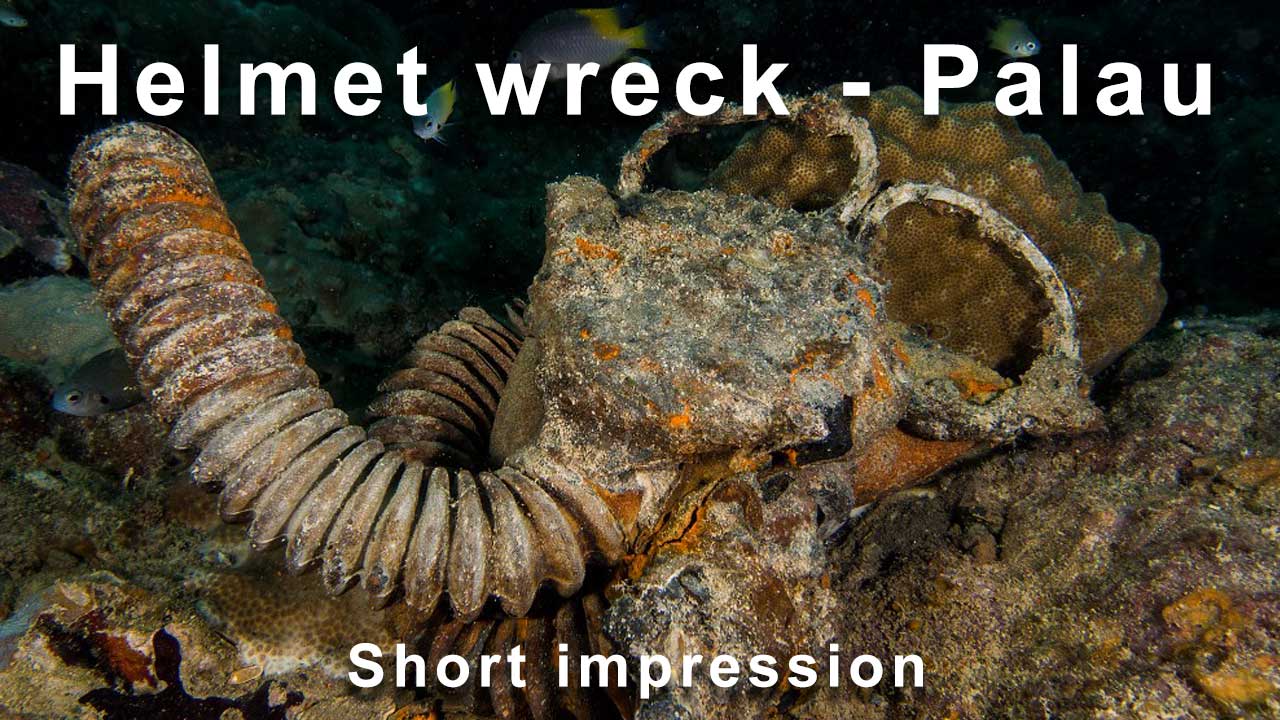
Conclusion
All-in-all, this is a wreck dive that must be experienced and opportunities for photography are excellent.
In summary, the Helmet Wreck offers a unique diving experience. The wreck’s history and fascinating features, such as the depth charge release boxes, stacks of helmets and rifles, and the huge radial aircraft engines, make it an excellent and rewarding dive site for those interested in exploring historical wrecks.
Please remember that there is plenty of dangerous, unexploded ordnance about, so be careful.
Divers should take caution and follow proper diving techniques to ensure their safety and preserve the integrity of the wreck. It is recommended to plan the dive carefully and maintain neutral buoyancy while visiting the wreck to avoid disturbing the silt and sediment.


